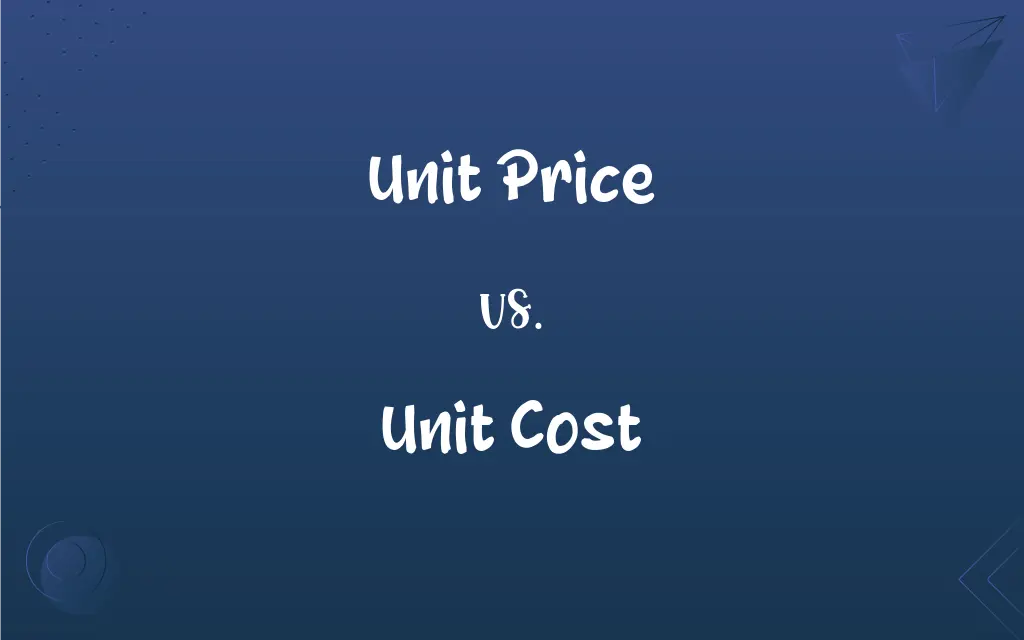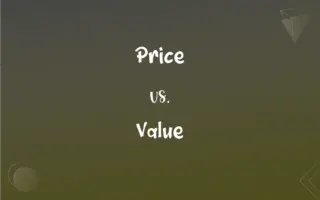Unit Price vs. Unit Cost: What's the Difference?
Edited by Aimie Carlson || By Harlon Moss || Published on January 20, 2024
Unit price is the amount a customer pays per unit of a product, whereas unit cost is the total expense incurred to produce, store, and sell one unit of a product.

Key Differences
Unit price represents the selling price of an individual item or service unit that the consumer pays. In contrast, unit cost refers to the total expense a company incurs in producing, storing, and selling a single unit of a product or service.
When setting the unit price, businesses consider factors like market demand, competition, and desired profit margins. On the other hand, calculating unit cost involves adding up all the costs associated with production, including materials, labor, overhead, and any additional expenses.
The unit price is often visible to the consumer, as it's the price tag on goods or services. The unit cost, however, is typically internal company information, used to assess profitability and efficiency.
A major goal for businesses is to keep the unit cost lower than the unit price to ensure profitability. In this sense, the unit price must cover the unit cost and contribute to the company's profit margins.
The relationship between unit price and unit cost is crucial for business strategy; if the unit cost rises, the unit price may also need to increase to maintain profit margins, affecting market competitiveness and consumer demand.
ADVERTISEMENT
Comparison Chart
Definition
Price per unit paid by the customer
Total cost of production per unit
Determination
Based on market factors and profit margins
Calculated from production, labor, and overhead costs
Visibility
Visible to consumers
Typically internal to the company
Purpose
To determine selling price
To assess production efficiency and profitability
Relation to Profit
Must exceed unit cost for profitability
Should be minimized to maximize profit margins
ADVERTISEMENT
Unit Price and Unit Cost Definitions
Unit Price
Price for each unit of a product.
She calculated the unit price to determine the best value.
Unit Cost
Total expense per unit of output.
They reduced the unit cost by optimizing the production process.
Unit Price
Price per standard quantity.
The unit price on the shelf label made budgeting easier.
Unit Cost
Cost of production per individual item.
The unit cost analysis showed potential for profit margin improvement.
Unit Price
Amount charged to the customer per unit.
The unit price of the bottled water varied across stores.
Unit Cost
The cost incurred to produce a single unit.
The unit cost of manufacturing the gadget increased due to higher material prices.
Unit Price
The cost per single item or measure.
The unit price of the apples was $2 per pound.
Unit Cost
Per unit production expense including materials and labor.
Labor efficiency lowered the unit cost significantly.
Unit Price
Retail selling price per unit.
Checking the unit price helps compare deals.
Unit Cost
Aggregate cost divided by the number of units.
Increasing production volume helped decrease the unit cost.
FAQs
Is unit price always visible to customers?
Yes, it's the price customers see and pay.
What factors influence unit cost?
Material, labor, overhead, and production efficiency.
What role does unit cost play in pricing?
It's a baseline to ensure the unit price covers costs and profits.
How is unit price determined?
Based on market demand, competition, and profit targets.
Why is comparing unit prices useful for consumers?
It helps in finding the best value for money.
What is unit price?
The selling price per individual unit of a product.
Who uses unit cost information?
Primarily used internally by businesses for financial analysis.
Can unit price vary by retailer?
Yes, retailers set their unit prices independently.
Does unit price include taxes?
It can vary; in some places, taxes are added to the displayed unit price.
Are unit prices regulated by any authority?
They can be subject to trade and consumer protection laws.
How does technology impact unit cost?
Advanced technology can reduce production costs.
What does unit cost mean?
The total cost to produce a single unit of a product.
Is unit cost affected by production volume?
Yes, higher volume often lowers the unit cost.
Does unit cost include marketing expenses?
Yes, it can include all costs associated with the product.
What happens if unit cost exceeds unit price?
The business might incur losses on those products.
Can unit price be negotiated?
In B2B transactions, yes; less commonly in retail.
How do economies of scale affect unit price?
They can allow for a lower unit price while maintaining profitability.
Can unit cost information be confidential?
Yes, businesses often keep this information private.
How can a business reduce unit cost?
By improving operational efficiency and reducing expenses.
Is unit price important for budgeting?
Yes, especially for consumers comparing products.
About Author
Written by
Harlon MossHarlon is a seasoned quality moderator and accomplished content writer for Difference Wiki. An alumnus of the prestigious University of California, he earned his degree in Computer Science. Leveraging his academic background, Harlon brings a meticulous and informed perspective to his work, ensuring content accuracy and excellence.
Edited by
Aimie CarlsonAimie Carlson, holding a master's degree in English literature, is a fervent English language enthusiast. She lends her writing talents to Difference Wiki, a prominent website that specializes in comparisons, offering readers insightful analyses that both captivate and inform.






































































